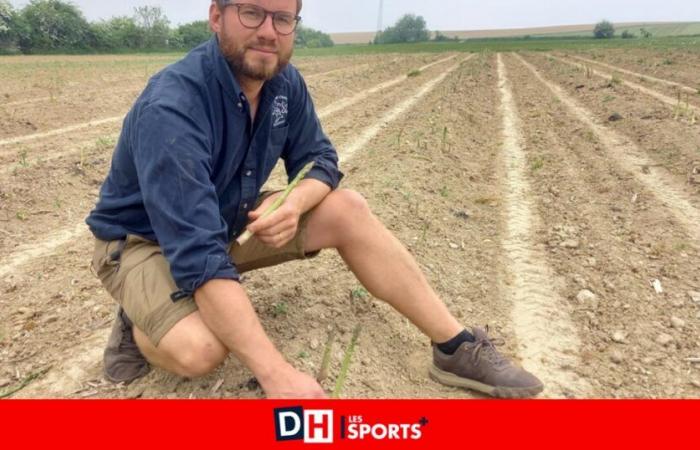In 2012, on a half-hectare plot, he planted a first plot. The earth is clay-saltworm, so not particularly rich in sand when it is often heard that the asparagus love the sand to push it. “Not necessarily. The asparagus grows in many types of soil. It is just necessary that it is not too heavy, therefore too clay, that it is draining.” Maxime Flamant opts for green asparagus rather than for white for a question of ease of harvest: mechanization is easier with the green, harvested out of the ground, while the white people are cut in the soil itself.
“Very reasoned” agriculture
Since 2012, two other plots have been planted. Is that it is necessary to plan the end of the production of the first: “It takes ten years of good production. Beyond that, asparagus become finer. This has no effect on their taste, but profitability is better with larger.” He opts for a culture which he describes as “Very reasoned”approaching a maximum of the specifications of the organic. Thus, he never treats the plants against pests – in particular small beetles – during harvest periods. “Only, outside, if the attack is important.”
This year, contrary to what one might think, the conditions are good for asparagus. “It takes water, and we have had enough before it is drier. And it has been hot in recent days. At 20, 25 °, a asparagus can grow 10 cm in a day! Above all, we did not have jelly, fatal to young shoots.” Consequence of these favorable conditions: “The start of production is in the good average: since April 16, the sooner the start of this month.” A plant produces around 500 grams of asparagus per year. But difficult for him to assess his annual production.
Good profitability
After a dozen years of asparagus culture, Maxime Flamant draws a good assessment: “It is a relatively easy to cultivate plant. It is financially interesting, profitability is good. But I am a good customer of my osteopath …” he smiles. Because if he uses mechanization, work, in a leaning position, also requests his back abundantly … He points to another drawback … which he was able to integrate into his work: “Asparagus requires time in the spring, intense moment for sowing other cultures.” This is why, within the exploitation, he devoted himself to the pressing of apples on the farm in September. He also grows sweet potatoes. Ideal complementarity activities.
The producer has chosen his asparagus by channels outside of large distribution. “Especially by the cooperative peasants craftsmen, but also in stores on the farm and in some restaurants in the region.” He also devotes less presentable asparagus to make soup for children welcomed at the farm (see below). And of course for his personal consumption. What he prefers? “Raw asparagus, in the field”he said, crunching one with their full teeth.
A pioneer and renowned educational farm
Acquired by Michel Flamant in 1985, La Ferme du Chant d’Oiseaux is a splendid building in the center of a 100 hectare farm, explains his wife, Françoise Philippart. But the domain has managed to evolve and take advantage of its potentials, while preserving its character and highlighting agricultural work and its productions.
The representatives of the current generation, Maxime and Quentin Flamant, each exploit the land in their sector. The first is devoted to asparagus, apple juice and sweet potatoes; His brother cultivates in organic cereals, corn, potatoes, six vegetables as well as lenses, chickpeas and even quinoa whose Landenne farm was a precursor of culture in Wallonia.
But the farm is also rich in the educational activity that has been deployed there since 1992. An idea of Françoise Philippart, logged by training, who wanted to share everything she appreciated on her parents’ farm, to introduce what we make on a farm and what we produce there. Thus, up to 60 children can be welcomed in internships organized during school holidays. The rest of the year, the farm has 100 beds to accommodate students and teachers of schools in Wallonia and Brussels, “But some have already come from Lille, Luxembourg and even from Cologne”…
On the program: very concrete activities such as feeding animals, changing their litter, making apple juice. “There is always a playful aspect. And always we end up manufacturing leproduct from activity. For example, popcorn at the start of corn, bread at the start of cereals.” The woods and ponds of the estate are also places of discovery of nature, with a beautiful covered space allowing 60 people to make a barbecue there … And as youth also needs to let off steam, psychomotor and sporting activities are also offered … In connection with the farm, like a climbing wall fitted on a wall of the barn, a zip line, a via ferrata and even rural skiing, sort of water ski of a tractor!
The educational farm has taken the form of an ASBL, independent of agricultural activity. It employs 12 full -time people all year round and students in reinforcement in summer. “The team is multidisciplinary, with a teacher, gym teacher, nature guide, cook who is preparing four meals with local, seasonal foodstuffs.” All in an enchanting setting and in ideal conditions.
Infos: www.ferme-pedagogique.net








